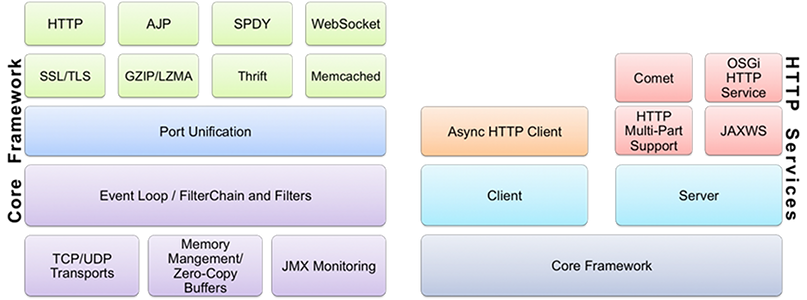Grizzy
用Java™编程语言编写可伸缩的服务器应用程序一直很困难。
在Java New I / O API(NIO)出现之前,线程管理问题使服务器无法扩展到数千个用户。
Grizzly NIO 框架旨在帮助开发人员利用Java™NIO API。
Grizzly的目标是帮助开发人员使用NIO构建可扩展且强大的服务器,并提供扩展的框架组件:Web框架(HTTP / S),WebSocket,Comet等等!
整体架构

快速开始
maven 引入
<dependency>
<groupId>org.glassfish.grizzly</groupId>
<artifactId>grizzly-framework</artifactId>
<version>2.4.0</version>
</dependency>
服务端
- EchoFilter.java
import java.io.IOException;
import org.glassfish.grizzly.filterchain.BaseFilter;
import org.glassfish.grizzly.filterchain.FilterChain;
import org.glassfish.grizzly.filterchain.FilterChainContext;
import org.glassfish.grizzly.filterchain.NextAction;
/**
* Implementation of {@link FilterChain} filter, which replies with the request
* message.
*/
public class EchoFilter extends BaseFilter {
/**
* Handle just read operation, when some message has come and ready to be
* processed.
*
* @param ctx Context of {@link FilterChainContext} processing
* @return the next action
* @throws java.io.IOException
*/
@Override
public NextAction handleRead(FilterChainContext ctx)
throws IOException {
// Peer address is used for non-connected UDP Connection :)
final Object peerAddress = ctx.getAddress();
final Object message = ctx.getMessage();
ctx.write(peerAddress, message, null);
return ctx.getStopAction();
}
}
可以看得出来这里和 netty 的区别,此处并没有将消息当做一个参数独立处理。
设计中,这是一种衡量。
哪一种比较常用?比较容易记忆?
- EchoServer.java
import java.io.IOException;
import java.nio.charset.Charset;
import java.util.logging.Logger;
import org.glassfish.grizzly.filterchain.FilterChainBuilder;
import org.glassfish.grizzly.filterchain.TransportFilter;
import org.glassfish.grizzly.nio.transport.TCPNIOTransport;
import org.glassfish.grizzly.nio.transport.TCPNIOTransportBuilder;
import org.glassfish.grizzly.utils.StringFilter;
/**
* Class initializes and starts the echo server, based on Grizzly 2.3
*/
public class EchoServer {
private static final Logger logger = Logger.getLogger(EchoServer.class.getName());
public static final String HOST = "localhost";
public static final int PORT = 7777;
public static void main(String[] args) throws IOException {
// Create a FilterChain using FilterChainBuilder
FilterChainBuilder filterChainBuilder = FilterChainBuilder.stateless();
// Add TransportFilter, which is responsible
// for reading and writing data to the connection
filterChainBuilder.add(new TransportFilter());
// StringFilter is responsible for Buffer <-> String conversion
filterChainBuilder.add(new StringFilter(Charset.forName("UTF-8")));
// EchoFilter is responsible for echoing received messages
filterChainBuilder.add(new EchoFilter());
// Create TCP transport
final TCPNIOTransport transport =
TCPNIOTransportBuilder.newInstance().build();
transport.setProcessor(filterChainBuilder.build());
try {
// binding transport to start listen on certain host and port
transport.bind(HOST, PORT);
// start the transport
transport.start();
logger.info("Press any key to stop the server...");
System.in.read();
} finally {
logger.info("Stopping transport...");
// stop the transport
transport.shutdownNow();
logger.info("Stopped transport...");
}
}
}
这里和 netty 的区别,应该是 api 的区别,对于 netty 是 fluent 的模式。
客户端
- ClientFilter.java
import java.io.IOException;
import org.glassfish.grizzly.filterchain.BaseFilter;
import org.glassfish.grizzly.filterchain.FilterChainContext;
import org.glassfish.grizzly.filterchain.NextAction;
/**
* Client filter is responsible for redirecting server response to the standard output
*/
public class ClientFilter extends BaseFilter {
/**
* Handle just read operation, when some message has come and ready to be
* processed.
*
* @param ctx Context of {@link FilterChainContext} processing
* @return the next action
* @throws java.io.IOException
*/
@Override
public NextAction handleRead(final FilterChainContext ctx) throws IOException {
// We get String message from the context, because we rely prev. Filter in chain is StringFilter
final String serverResponse = ctx.getMessage();
System.out.println("Server echo: " + serverResponse);
return ctx.getStopAction();
}
}
- EchoClient.java
import java.io.BufferedReader;
import java.io.IOException;
import java.io.InputStreamReader;
import java.nio.charset.Charset;
import java.util.logging.Logger;
import java.util.concurrent.ExecutionException;
import java.util.concurrent.Future;
import java.util.concurrent.TimeUnit;
import java.util.concurrent.TimeoutException;
import org.glassfish.grizzly.Connection;
import org.glassfish.grizzly.Grizzly;
import org.glassfish.grizzly.filterchain.FilterChainBuilder;
import org.glassfish.grizzly.filterchain.TransportFilter;
import org.glassfish.grizzly.nio.transport.TCPNIOTransport;
import org.glassfish.grizzly.nio.transport.TCPNIOTransportBuilder;
import org.glassfish.grizzly.utils.StringFilter;
/**
* The simple client, which sends a message to the echo server
* and waits for response
*/
public class EchoClient {
private static final Logger logger = Grizzly.logger(EchoClient.class);
public static void main(String[] args) throws IOException,
ExecutionException, InterruptedException, TimeoutException {
Connection connection = null;
// Create a FilterChain using FilterChainBuilder
FilterChainBuilder filterChainBuilder = FilterChainBuilder.stateless();
// Add TransportFilter, which is responsible
// for reading and writing data to the connection
filterChainBuilder.add(new TransportFilter());
// StringFilter is responsible for Buffer <-> String conversion
filterChainBuilder.add(new StringFilter(Charset.forName("UTF-8")));
// ClientFilter is responsible for redirecting server responses to the standard output
filterChainBuilder.add(new ClientFilter());
// Create TCP transport
final TCPNIOTransport transport =
TCPNIOTransportBuilder.newInstance().build();
transport.setProcessor(filterChainBuilder.build());
try {
// start the transport
transport.start();
// perform async. connect to the server
Future<Connection> future = transport.connect(EchoServer.HOST,
EchoServer.PORT);
// wait for connect operation to complete
connection = future.get(10, TimeUnit.SECONDS);
assert connection != null;
System.out.println("Ready... (\"q\" to exit)");
final BufferedReader inReader = new BufferedReader(new InputStreamReader(System.in));
do {
final String userInput = inReader.readLine();
if (userInput == null || "q".equals(userInput)) {
break;
}
connection.write(userInput);
} while (true);
} finally {
// close the client connection
if (connection != null) {
connection.close();
}
// stop the transport
transport.shutdownNow();
}
}
}
整体感受
对于使用者而言,api 是一种很直观的感受。
入门的文档也是很直观的感受。
这里抛开性能不谈,感觉入门的案例还是设计的太复杂了。
